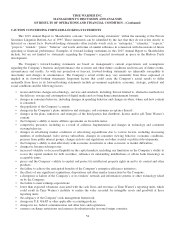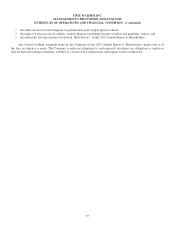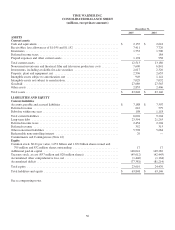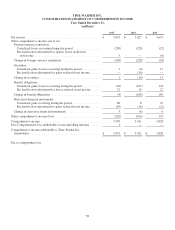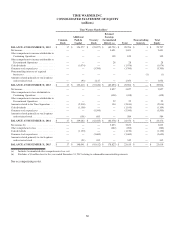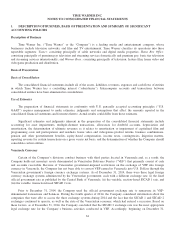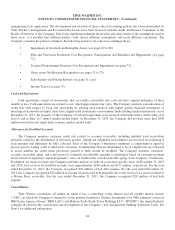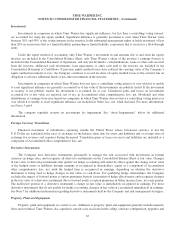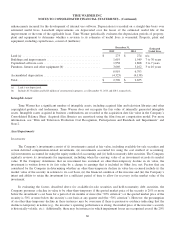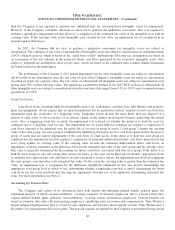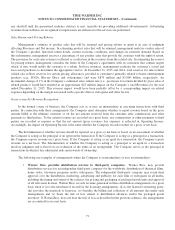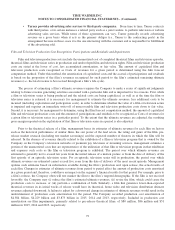Time Magazine 2015 Annual Report Download - page 77
Download and view the complete annual report
Please find page 77 of the 2015 Time Magazine annual report below. You can navigate through the pages in the report by either clicking on the pages listed below, or by using the keyword search tool below to find specific information within the annual report.TIME WARNER INC.
NOTES TO CONSOLIDATED FINANCIAL STATEMENTS - (Continued)
measure fair value. The adoption of this guidance did not have a material effect on the Company’s consolidated financial
statements.
Discontinued Operations
During the first quarter of 2015, the Company adopted guidance on a prospective basis that changed the requirements
for reporting discontinued operations. Under this new guidance, a discontinued operation is (i) a component of an entity or
group of components that has been disposed of or is classified as held for sale and represents a strategic shift that has had or
will have a major effect on an entity’s operations and financial results or (ii) an acquired business that is classified as held for
sale on the acquisition date. This guidance also requires expanded or new disclosures for discontinued operations,
individually material disposals that do not meet the definition of a discontinued operation, an entity’s continuing involvement
with a discontinued operation following disposal and retained equity method investments in a discontinued operation. The
adoption of this guidance did not have a material effect on the Company’s consolidated financial statements.
Accounting Guidance Not Yet Adopted
Recognition and Measurement of Financial Assets and Liabilities
In January 2016, guidance was issued that makes targeted changes to the accounting for financial instruments. The
changes primarily relate to (i) the requirement to measure equity investments in unconsolidated subsidiaries, other than those
accounted for under the equity method of accounting, at fair value, with changes in the fair value recognized in earnings, (ii)
an alternative approach for the measurement of equity investments that do not have a readily determinable fair value, (iii) the
elimination of the other-than-temporary impairment model and its replacement with a requirement to perform a qualitative
assessment to identify the impairment of equity investments, and a requirement to recognize impairment losses in earnings
based on the difference between fair value and the carrying value of the equity investment, (iv) the elimination of the
requirement to disclose the methods and significant assumptions used to estimate the fair value of financial instruments
measured at amortized cost, (v) the addition of a requirement to use the exit price concept when measuring the fair value of
financial instruments for disclosure purposes, and (vi) the addition of a requirement to present financial assets and financial
liabilities to be presented separately in the notes to the financial statements, grouped by measurement category (e.g., fair
value, amortized cost, lower of cost or market) and form of financial asset (e.g., loans, securities). This guidance will become
effective for the Company on January 1, 2018. The Company is evaluating the impact this guidance will have on its
consolidated financial statements.
Revenue Recognition
In May 2014, guidance was issued that establishes a new revenue recognition framework in GAAP for all companies
and industries. The core principle of the guidance is that an entity should recognize revenue from the transfer of promised
goods or services to customers in an amount that reflects the consideration the entity expects to receive for those goods or
services. The guidance includes a five-step framework to determine the timing and amount of revenue to recognize related to
contracts with customers. In addition, this guidance requires new or expanded disclosures related to the judgments made by
companies when following this framework. Based on the current guidance, the new framework will become effective on
either a full or modified retrospective basis for the Company on January 1, 2018. The Company is evaluating the impact the
guidance will have on its consolidated financial statements.
Summary of Critical and Significant Accounting Policies
The following is a discussion of each of the Company’s critical accounting policies, including information and analysis
of estimates and assumptions involved in their application, and other significant accounting policies.
The Securities and Exchange Commission (“SEC”) considers an accounting policy to be critical if it is important to the
Company’s financial condition and results of operations and if it requires significant judgment and estimates on the part of
63



